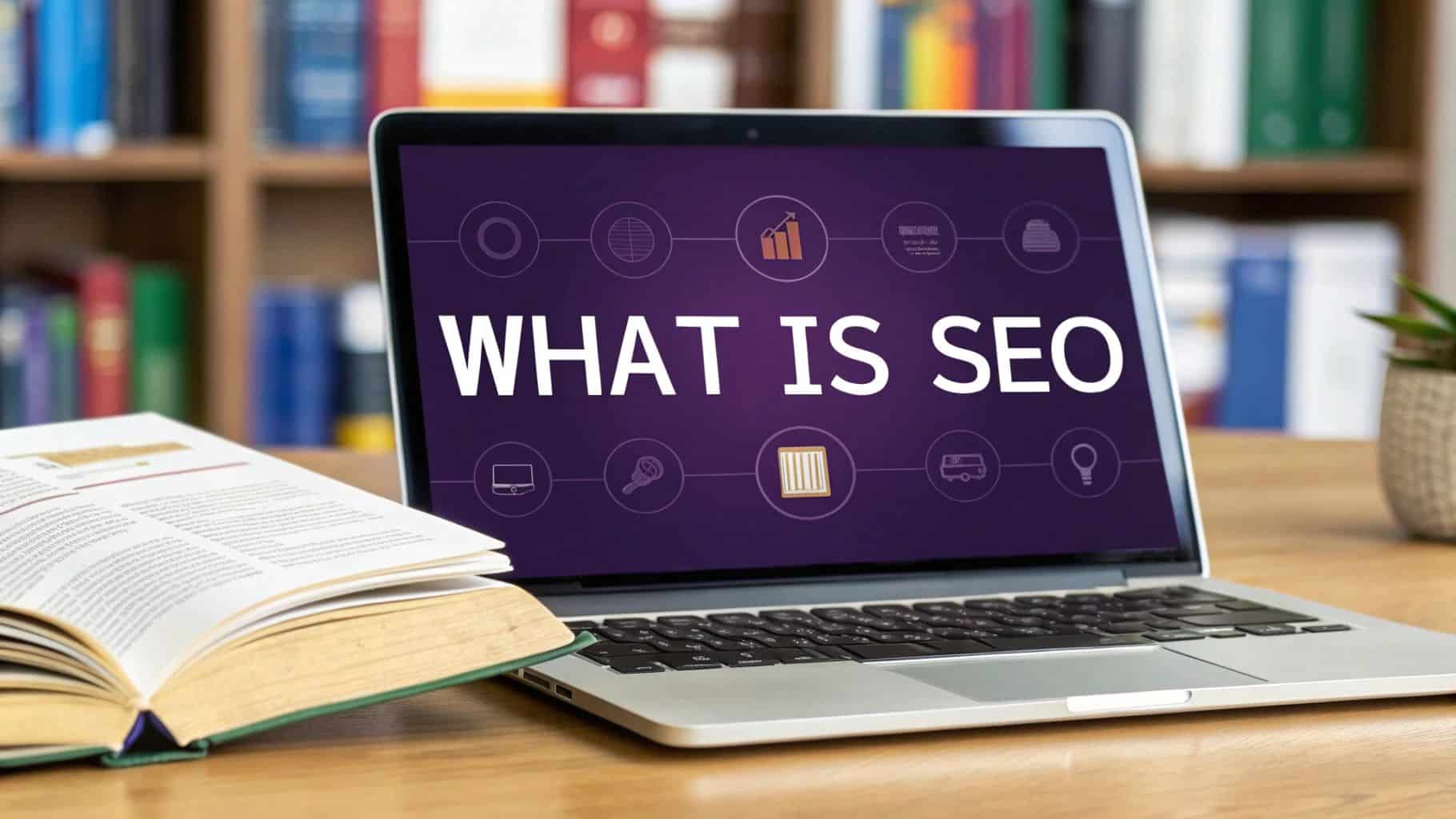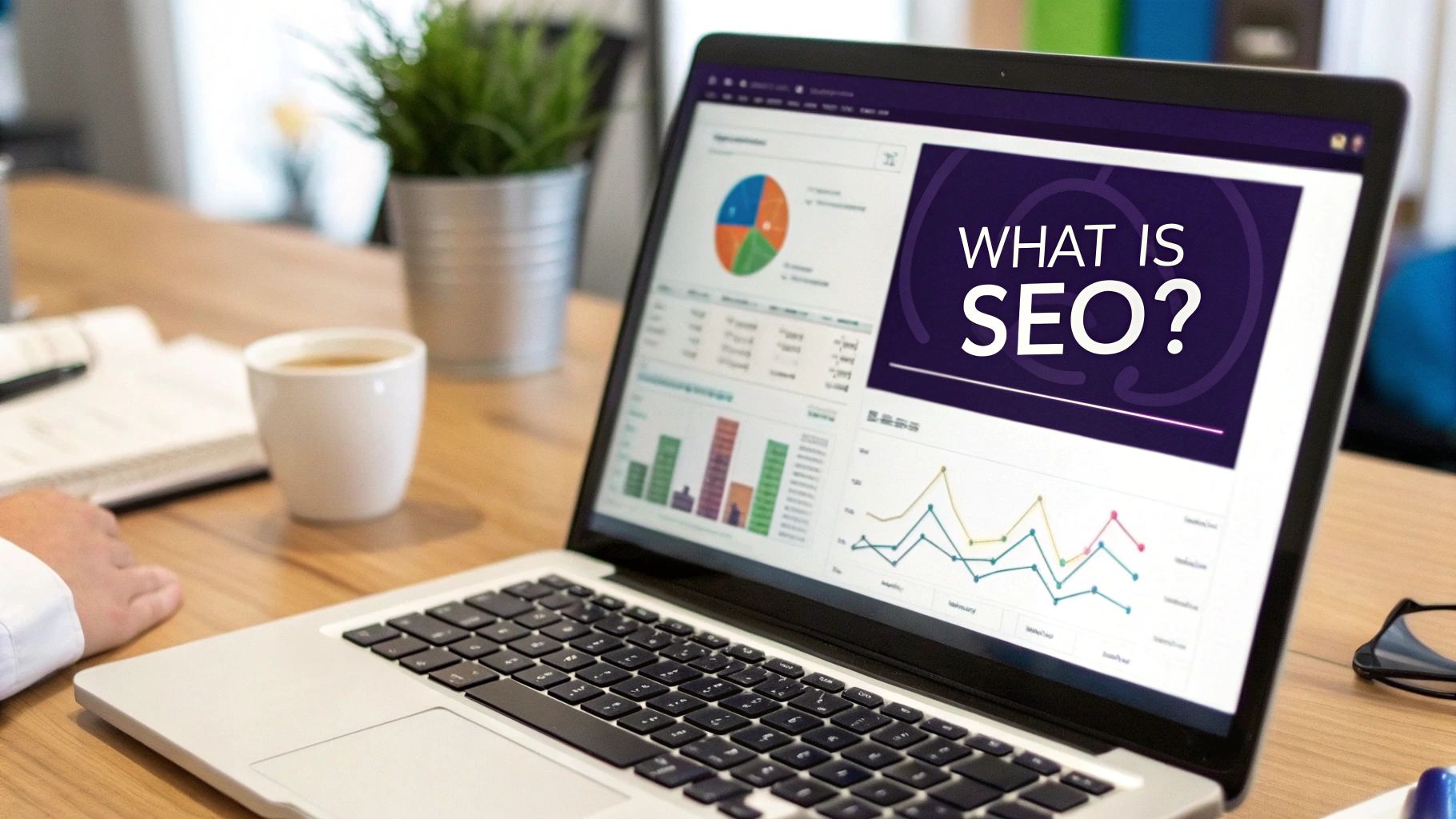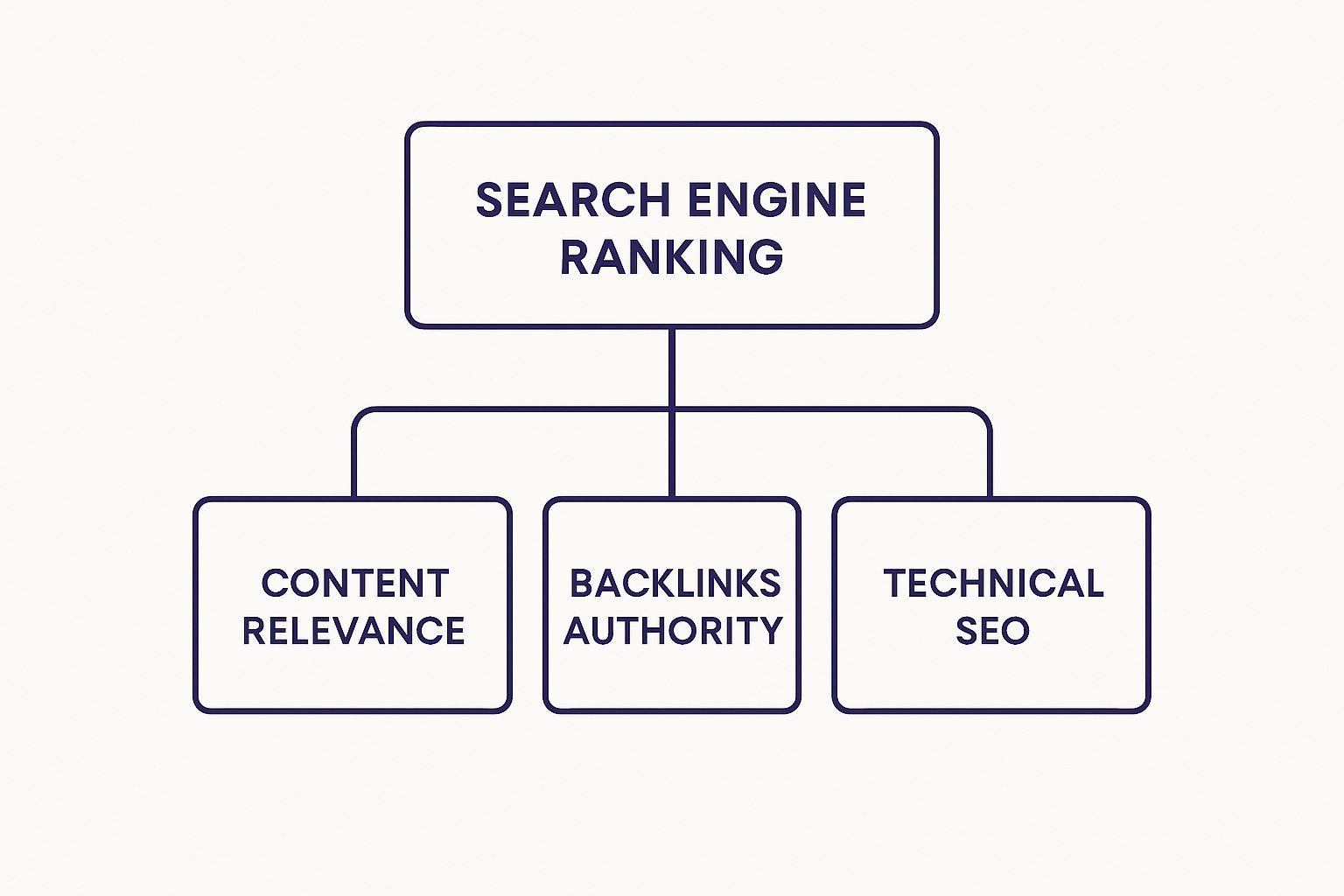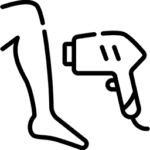What Is Search Engine Optimization for Business

Ever heard of Search Engine Optimization (SEO)? At its core, it's the art and science of fine-tuning your website so it pops up when potential clients are searching for your services on Google.
Think of it this way: SEO is what gets your salon featured on the busiest street on the internet instead of being tucked away in some digital back alley where no one can find you.
What SEO Really Means for Your Business

Let’s cut through the tech talk. Imagine Google is a massive library, and every website—yours included—is a book on its shelves. When someone types "balayage artist near me" into the search bar, they're essentially asking the librarian (Google) for the best book on that topic.
SEO is everything you do to convince that librarian that your book is the most relevant, trustworthy, and high-quality recommendation. It’s not about tricking the system; it’s about proving you have the best answers.
Why This Matters for Your Beauty Business
Let’s be real: without a solid SEO strategy, your gorgeous website is like a stunning salon with no sign out front. Potential clients will walk right past, completely unaware you exist. If you want a deeper dive into the mechanics, this guide on What is Search Engine Optimization Explained is a great place to start.
This visibility directly impacts your bottom line. A well-optimized website doesn't just attract random visitors; it brings in people who are actively looking for the exact services you offer. These aren't just leads; they're highly motivated clients ready to book.
The whole point of SEO is to drive sustainable growth by attracting qualified traffic—people ready to book appointments—directly to your website without paying for every single click.
This process involves a few key activities, but they all share one common goal: to prove your website’s value and authority to both search engines and the people using them.
Good SEO ensures that when a potential client needs a new hairstylist, esthetician, or nail tech, your business is one of the first they see. This isn't just fluffy marketing; it's a fundamental part of building a successful modern business. Here's what it helps you do:
- Increase organic traffic: Get more visitors from search results without paying for ads.
- Build brand credibility: Ranking high on Google naturally builds trust with potential clients.
- Generate qualified leads: Connect with people searching for your specific beauty services at the exact moment they need them.
Ultimately, getting a grip on SEO gives you the power to turn your website into a client-generating machine that works for you 24/7.
How Search Engines Actually Find and Rank Your Website
To really get what SEO is all about, you have to peek behind the curtain and see how search engines like Google operate. It’s not a secret code; it's a highly organized system. The best way to think about Google is as the ultimate librarian for the entire internet, with three main jobs to tackle every single day.
This whole process has been fine-tuned for decades. SEO as a practice kicked off back in the mid-1990s with the first search engines. The term 'search engine optimization' officially popped up around 1997. But the real game-changer was Google's PageRank algorithm in 1998, which started ranking sites based on how relevant and authoritative they were. This forced everyone to start creating better, more strategic content—a rule that’s more important than ever today.
Step 1 Crawling Is Digital Discovery
First up is crawling. Search engines send out little automated bots, often called "crawlers" or "spiders," to explore the internet. These crawlers are like tireless digital explorers, roaming the web 24/7, looking for new or updated pages to add to their map.
They travel from link to link, discovering new content along the way. For your salon's website, a crawler might land on your homepage, then follow the links to your services page, your gallery, and your "About Us" page. This is the absolute first step to getting seen on Google. If your site can't be found by these crawlers, it's pretty much invisible.
Step 2 Indexing Is The Grand Filing System
Once a crawler discovers your pages, the next job is indexing. This is where the librarian takes your webpage, figures out what it's all about, and files it away in a massive digital library. The search engine analyzes everything on your page—the text, the images, the videos—to understand the topic.
It zooms in on key elements to get the context right:
- Page Titles and Headings: It checks what you've marked as the most important info.
- Keywords: It identifies the main phrases you use, like "balayage specialist" or "luxury spa facial."
- Image Alt Text: It even reads the descriptions of your photos to understand the visual content.
Think of it this way: indexing is the process of neatly organizing all the discovered information so it can be pulled up in a split second when someone searches for it. A well-indexed site is one that Google totally gets and can confidently show as a potential answer.
Step 3 Ranking Is The Final Judgment
The final and most crucial job is ranking. When someone types a search like "best nail art in Austin," the search engine instantly digs through its enormous index for all the relevant pages it has filed away. This is where the SEO magic truly happens.
In less than a second, Google’s algorithm sorts through hundreds of factors to decide which pages are the most helpful and trustworthy. It's asking a ton of questions, like:
- Which website is the most relevant to what this person is looking for?
- Which site is the most authoritative and trusted expert on this topic?
- Does this website give people a good experience, especially on their phones?
Based on the answers, Google ranks the results, putting what it thinks is the absolute best answer right at the top. Your goal with SEO is to prove to Google that your website is the #1 result for the beauty services you rock.
The Three Core Pillars of a Strong SEO Strategy
Knowing how search engines work is one thing, but actually getting your business to show up in the results? That requires a real strategy. Good SEO isn’t a one-and-done task; it’s a balanced approach built on three core pillars. If you neglect one, the whole thing gets wobbly.
Think of it like building your dream salon. You need a solid foundation and good plumbing (Technical SEO), a beautifully designed interior that clients love (On-Page SEO), and a stellar reputation around town (Off-Page SEO).
Let's break down exactly what each pillar involves and what actions you can take for your business.

As you can see, hitting the top of Google means balancing great content, a strong reputation, and a website that works flawlessly behind the scenes.
To give you a clearer picture, here's a quick breakdown of how these three pillars work together.
The Three Pillars of SEO at a Glance
| Pillar | Main Focus | Actionable Examples for a Business Owner |
|---|---|---|
| On-Page SEO | Creating relevant, high-quality content directly on your website pages. | Writing a blog post on "Aftercare for Gel Manicures," optimizing your service pages for terms like "balayage in [Your City]," and adding descriptive alt text to your portfolio images. |
| Off-Page SEO | Building your website's authority and reputation through external signals. | Getting your salon featured on a local beauty blog, ensuring your business is listed on Yelp, and collaborating with a local wedding photographer who links to your site. |
| Technical SEO | Ensuring your website's backend is optimized for search engine crawlers and provides a good user experience. | Making sure your website loads lightning-fast on mobile phones, securing your site with HTTPS, and creating a clear sitemap so Google can find all your pages. |
Now that you have the big-picture view, let’s dig a little deeper into what you can do for each one.
Pillar 1: On-Page SEO
On-Page SEO is everything you do on your actual website. This is your turf. It’s where you make it crystal clear to both clients and search engines what your services are about and why you’re the expert.
For a business owner, this is the most direct and accessible place to start. Your goal here is to create amazing content that answers your clients' questions before they even ask them.
Here are a few actionable steps you can take right away:
- Create Genuinely Helpful Content: Think like your clients. Write blog posts, service descriptions, and FAQs that solve their problems. A post titled "5 Things to Know Before Getting Lash Extensions" is a perfect example.
- Use Keywords Naturally: Sprinkle relevant keywords and phrases (like "brazilian wax" or "gel manicure") into your page titles, headings, and paragraphs. Don't force it—just write like you're talking to a client.
- Optimize Your Images: Use high-quality photos of your incredible work. Just be sure to give them descriptive file names and alt text (e.g., "blonde-balayage-on-long-hair.jpg") so Google knows what they are.
Pillar 2: Off-Page SEO
Next up is Off-Page SEO. This covers all the things you do outside of your website to build its reputation and authority. If On-Page SEO is what you say about your business, Off-Page SEO is what everyone else on the internet says about you.
The biggest piece of this puzzle is earning backlinks. A backlink is just a link from another website pointing to yours.
Think of backlinks as votes of confidence. When a popular local beauty blog links to your salon's website, they're basically telling Google, "Hey, this business is legit and we trust them."
Here’s how you can build your off-page presence:
- Get Listed in Local Directories: Make sure your business name, address, and phone number are accurate and consistent on platforms like Yelp, Yellow Pages, and other local directories.
- Collaborate with Local Businesses: Partner with complementary businesses, like a wedding planner who can feature your bridal makeup services and link to your site.
- Engage with Your Community: Join local Facebook groups or online forums. Offer your expert advice to establish yourself as the go-to pro in your area, and include your website link in your profile.
Pillar 3: Technical SEO
Finally, there’s Technical SEO. This is all the behind-the-scenes stuff that makes it easy for search engines to find, crawl, and understand your website. It's the essential "housekeeping" that ensures everything runs smoothly for both Google's bots and your human visitors.
While it sounds intimidating, many of the basics are pretty straightforward. The goal is simply to remove any technical roadblocks that might be holding you back. For those wanting a helping hand, exploring the best SEO tools for small businesses can make a world of difference.
Key technical tasks to keep an eye on:
- Site Speed: Your website needs to load fast. You can test your site's speed for free using Google's PageSpeed Insights tool.
- Mobile-Friendliness: Most local searches happen on a phone. Your website absolutely must look and work perfectly on mobile devices. Use Google's Mobile-Friendly Test to check your site.
- A Secure Site (HTTPS): Having that little padlock next to your URL isn't just nice to have; it's a standard requirement. Most website builders offer this feature easily.
Your First Actionable SEO Steps
Understanding the theory is a great start, but real results come from doing. This is your launchpad—a few straightforward steps designed to land you your first real SEO win.
We’ll start by figuring out what your potential clients are actually searching for. Then, we’ll put that knowledge to work by optimizing a page on your website before setting up your digital storefront on Google to start pulling in local customers right away.
Start with Smart Keyword Research
Before you can optimize a single thing, you need to get inside your ideal client's head and know the exact words and phrases they're typing into Google. This is called keyword research, and it’s way less about technical wizardry and more about pure customer empathy.
Imagine someone in your city needs a new hairstylist. They likely search for specific phrases like "balayage specialist near me" or "best salon for curly hair in [Your City]." These detailed phrases are your golden tickets.
Here’s an easy, actionable way to find them using Google:
- Open Google: Start typing a service you offer, like "lash extensions."
- Watch Autocomplete: Pay close attention to the suggestions Google automatically offers. You might see things like "lash extensions classic vs hybrid" or "lash extensions aftercare." These are real searches from real people.
- Check "People Also Ask": After you search, look for the "People Also Ask" box. This is a goldmine of questions your clients want answers to, like "How long do lash extensions last?"
- Analyze Related Searches: Scroll all the way to the bottom of the page. Google gives you a list of "Related searches" that can spark even more ideas for content.
By spending just 15-20 minutes on this, you'll have a solid list of keywords that reflect what your customers are actually thinking. Your goal is to find the language your clients use, not the industry jargon you might use with other pros.
Optimize a Page on Your Website
Now you've got a target keyword—let's use "deep tissue massage Austin." It's time to put it to work. Pick one service page on your website, and let's give it an optimization makeover. This process tells Google exactly what your page is about so it can show it to the right people.
There are three key spots you need to update:
- Page Title (Title Tag): This is the main headline that shows up in the Google search results and in the browser tab. It's your most important signal to Google, so make it clear and compelling.
- Meta Description: This is the short paragraph that appears under your page title in the search results. While it doesn't directly affect your rankings, a good one convinces people to click on your link instead of a competitor's.
- Headings (H1, H2): These are the headlines on your actual webpage. Your main headline should be your H1, and subheadings should be H2s. They give your page structure and tell Google what's most important.
Think of it like labeling a file folder. A clear, accurate label (your Page Title and H1) ensures the librarian (Google) knows exactly what's inside and can hand it to the right person when they ask.
Here’s a simple before-and-after for a massage therapist's page to show you how to apply this:
| Element | Before Optimization | After Optimization |
|---|---|---|
| Page Title | Our Services | Deep Tissue Massage in Austin |
| Meta Description | We offer a variety of massage services to help you. | Experience the best deep tissue massage in Austin. Our certified therapists help relieve chronic pain and tension. Book your session today! |
| Main Heading (H1) | What We Do | Austin's Premier Deep Tissue Massage |
These small tweaks make a massive difference in how Google understands and ranks your page. You can apply this same process to every service page on your site.
Claim Your Google Business Profile
For any local business, your Google Business Profile (GBP) is your most powerful free SEO tool. It's the information box that pops up on Google Maps and in local searches, showing off your address, hours, photos, and reviews. For attracting nearby clients, optimizing it is non-negotiable.
Here is your step-by-step guide to get it done:
- Create or Claim Your Profile: Go to google.com/business and search for your business name. You can either claim an existing listing if one pops up or create a new one from scratch.
- Complete Every Single Section: Fill out absolutely everything. Add your services, business hours, address, phone number, and a detailed, keyword-friendly business description. The more info you give Google, the better.
- Upload High-Quality Photos: Show off your beautiful space! Post pictures of your talented team and examples of your amazing work. Profiles with photos get 42% more requests for driving directions.
- Start Gathering Reviews: Actively ask your happy clients to leave you a review. Send them a direct link after their appointment. Positive reviews are a huge trust signal for both potential customers and Google.
Your Google Business Profile is often the very first interaction a potential client has with your brand. By optimizing it, you're putting your business on the map—literally—and creating a direct path for local customers to find you.
Why SEO Is a Long-Term Business Asset
Most business owners get stuck thinking about marketing in terms of paid ads. You pay, you get traffic. You stop paying, the traffic vanishes. It’s a bit like renting an audience. Search Engine Optimization completely flips that model on its head, turning your marketing from a temporary expense into a valuable, long-term asset you actually own.
Unlike a paid ad campaign that disappears the second your budget dries up, every single piece of optimized content you create and every backlink you earn builds on top of the last. This creates a powerful snowball effect, what we in the industry call compounding returns.
The Power of Compounding Returns in SEO
Think of your SEO efforts like investing in a retirement fund instead of just buying a lottery ticket. The first few contributions might not look like much, but when you stay consistent, that small investment starts to grow on its own, eventually snowballing into something massive.
Each blog post or service page you optimize is a small deposit. As it starts ranking on Google and pulling in visitors, it builds authority for your entire website. This newfound authority makes it easier for your next piece of content to rank, and the next, creating a cycle where your visibility and traffic grow at an accelerating rate. The work you put in today will keep paying you back with clients for months, and even years, to come.
SEO is the only marketing channel that has the potential to grow your traffic and leads over time without you having to continuously increase your spending. It builds a sustainable pipeline of customers who are actively searching for you.
This approach creates a predictable and reliable stream of clients. Instead of constantly chasing the next lead, you’re building a digital foundation that brings them right to your door.
SEO vs. Paid Ads: A 12-Month Horizon
Let’s get real and compare the two. Imagine a beauty business owner sets aside a marketing budget to use over one year.
-
Paid Ads (PPC): In Month 1, they spend their budget and see an immediate rush of website visitors and bookings. Awesome for a quick win! But fast forward to Month 12—they have to spend the exact same amount just to get the same level of traffic. The moment they stop paying, the traffic flatlines. It drops to zero.
-
Search Engine Optimization (SEO): In Month 1, the results are pretty quiet as Google starts to crawl and index the new optimizations. By Month 6, organic traffic is starting to pick up noticeably as their pages climb the rankings. By Month 12, the website is getting a steady flow of free traffic that often blows past what the paid ad budget could have generated. Best of all, it keeps coming in even if the marketing budget gets trimmed back.
This long-term value is exactly why businesses are pouring money into their online presence. SEO has ballooned into a massive global industry, estimated to be worth over $86.8 billion by 2025. This isn't just hype; it's driven by the fact that Google owns over 90% of the global search market. Its algorithms are the ultimate guide to getting seen online, forcing businesses to step up their game with quality content and a great user experience. If you're curious, you can learn more about the history of SEO and how we got here.
Building a Lasting Digital Foundation
At the end of the day, choosing SEO is about playing the long game. It demands patience and consistent effort, but the payoff is a powerful, self-sustaining marketing machine. You aren't just renting attention for a month; you are building an asset that strengthens your brand, cements you as an authority, and generates a stream of free, high-intent traffic for years.
This strategy is a crucial part of any healthy marketing mix. For more ideas on how to grow your business online, our guide has some fantastic digital marketing tips for small businesses. By investing in SEO, you ensure your business stays visible and competitive long after your ad campaigns have faded away.
Common Questions About SEO Answered

Diving into SEO can feel like learning a new language, filled with weird terms and moving parts. It’s totally normal to feel a bit overwhelmed at first.
To cut through the noise, we've rounded up the questions we hear most from salon and spa owners. Think of this as your personal cheat sheet—no jargon, just straight answers to help you feel confident and ready to get found online.
How Long Does SEO Take to Show Results
This is the big one, isn't it? The most honest answer is: it depends. SEO isn't an overnight magic trick. It's more like planting a garden—it takes time, care, and consistency to see things bloom.
Generally, you can expect to see the first signs of progress within 3 to 6 months. This might look like a small bump in website visitors or starting to rank for a few specific search terms, like "lash extensions in uptown."
However, for significant, appointment-booking results—like landing on the first page for competitive keywords—you're typically looking at 6 to 12 months of consistent effort. Factors like your website's age, local competition, and the quality of your SEO work all play a role.
SEO is a marathon, not a sprint. The groundwork you lay in the early months is what builds a strong, lasting foundation for clients to find you for years to come.
Can I Do SEO Myself or Should I Hire an Expert
The great news? You can absolutely get started with SEO on your own. You don’t need to be a tech wizard to handle the basics that make a real difference.
Here's an actionable checklist of what you can tackle yourself:
- On-Page SEO Basics: You know how to describe your services best! Writing clear page titles, catchy meta descriptions, and helpful content for your website is all you.
- Keyword Research: You're the expert on your clients. Use the Google search bar method mentioned earlier to find the phrases they use to find services like yours.
- Google Business Profile: Claiming and filling out your GBP is one of the single most powerful local SEO moves you can make, and it’s completely free.
So, when does it make sense to call in a pro? If you're short on time, in a super competitive market, or hit a technical snag, an SEO specialist can help speed things up and navigate the tricky parts. Many business owners find a happy medium: handling the on-page content themselves and hiring an expert for technical optimization and link building.
What Is the Difference Between SEO and SEM
It's easy to get these two mixed up. The simplest way to think about it is that Search Engine Marketing (SEM) is the big umbrella, and SEO is just one piece of it.
SEM is made up of two main parts:
- SEO (Search Engine Optimization): This is the organic, unpaid strategy. It’s all about earning your spot in search results naturally. The traffic you get is "free"—you're not paying Google for every click.
- PPC (Pay-Per-Click): This is the paid side, like Google Ads. You’re essentially buying ad space at the top of the search results. You pay a fee every single time someone clicks on your ad.
Basically, SEO earns you long-term visibility, while PPC buys you immediate visibility. A smart digital strategy often uses both. For example, many beauty businesses pair their SEO efforts with a killer visual strategy, as we cover in our guide to social media marketing for beauty salons.
How Do I Know if My SEO Is Working
You need to know if all this effort is actually paying off, right? The key is to track the metrics that really matter to your bottom line, not just vanity numbers.
Instead of obsessing over your ranking every single day, focus on these three Key Performance Indicators (KPIs):
- Organic Traffic: This is the number of people finding your website through a regular, unpaid search. A steady upward trend is a fantastic sign.
- Keyword Rankings: Keep an eye on where you stand for your most important keywords (like "balayage in downtown"). Seeing your site jump from page three to page one is a concrete win.
- Conversions: This is the most important one. Are people actually booking appointments or calling you? Tracking how many website visitors turn into clients tells you if your SEO is bringing in actual business.
You don't need fancy, expensive tools for this. Google Analytics and Google Search Console are completely free and give you all the data you need to see what’s working and prove your efforts are bringing in real results.
Ready to build a stunning website that clients can actually find? At gohappybeauty, we create beautiful, SEO-optimized websites designed specifically for beauty professionals like you. Get started today and watch your business grow!
Grow your beauty business
Our focus is, and always will be, helping you improve your online presence and generate more business from your website. That is what we do, for you.

